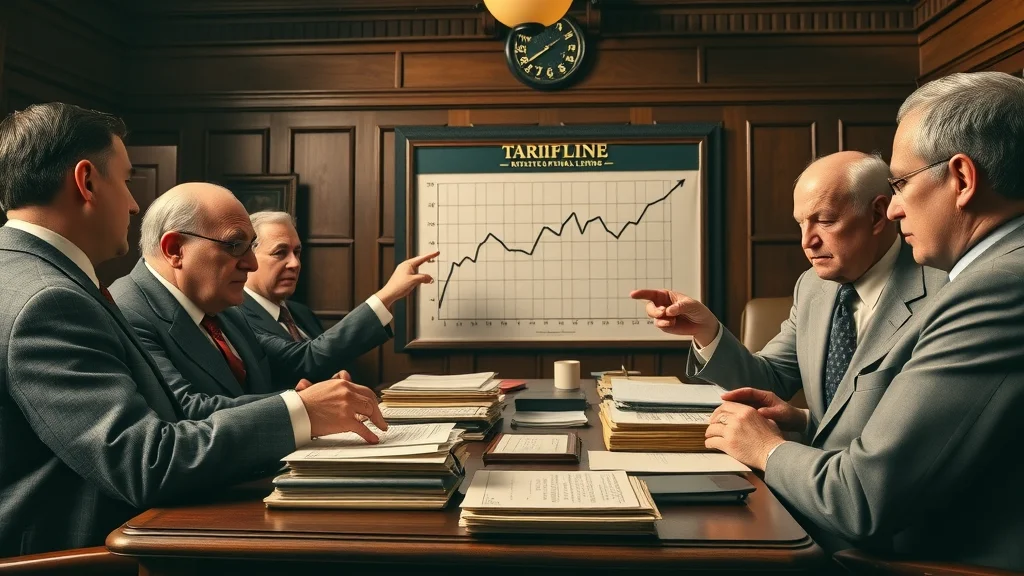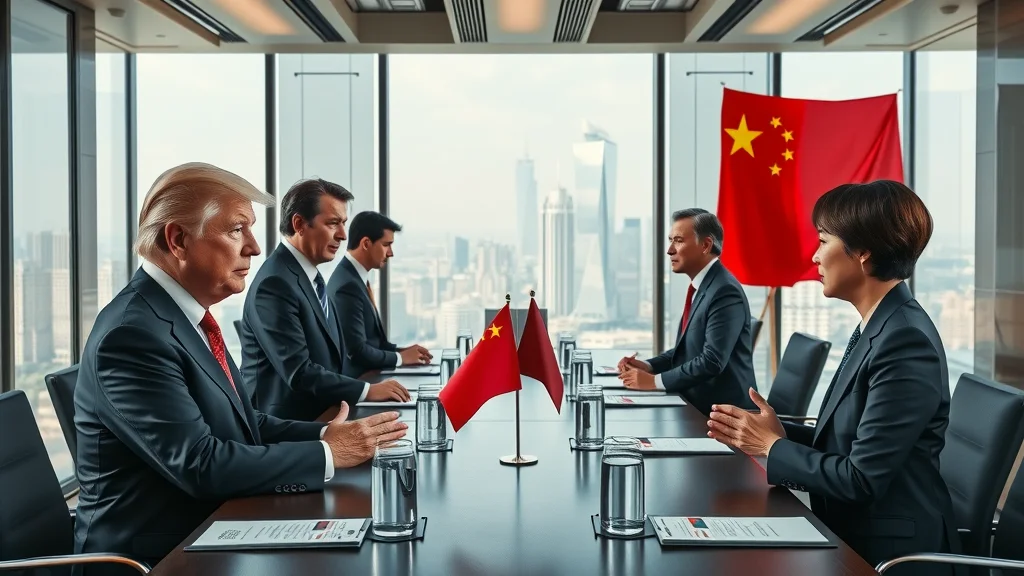Imagine a single decision affecting billions—“In 2018, the United States imposed tariffs on $250 billion worth of Chinese goods, leading to global market ripples and unexpected economic shifts.” Most headlines tell us tariffs protect jobs or punish foreign competitors, but few explain the deep, long-term economic impact of tariffs on our everyday lives. From food prices at your local market to the supply chains of factories across America, tariffs manipulate economies in ways that policymakers and the public rarely discuss. In this article, we break down the true cost, uncover hidden consequences, and share what leaders often miss when shaping trade policy.

Shattering Myths: The True Economic Impact of Tariffs
"In 2018, the United States imposed tariffs on $250 billion worth of Chinese goods, leading to global market ripples and unexpected economic shifts."
The myth that tariffs only raise the cost of imported goods underestimates their full power. In reality, tariffs provoke trade wars, disrupt supply chains, and create price increases for both consumers and manufacturers across the globe. The United States has often positioned tariffs as a defensive tool, but recent trade policy shifts—especially under the Trump administration—have shown that these decisions quickly evolve into a larger economic struggle.
When policymakers use the effective tariff rate as a blunt policy tool, the negative effects ripple from factories to household budgets. Imported goods become more expensive, triggering tax increases that rarely translate into the promised job growth or GDP gains. Instead, retaliatory tariffs from trading partners often boomerang and hurt domestic industries. These complex dynamics are frequently overlooked in the heated rhetoric surrounding tariff policy.

Understanding the 'Economic Impact of Tariffs' Beyond Headlines
- Unpacking the United States’ role in global tariff policy
- The persistent rhetoric of trade war
- Why policymakers often miss the nuanced economic impact
Going past headlines about the trade war, it’s clear that the economic impact of tariffs is more than just lost exports or increased tax revenue. Since the United States is the world’s largest economy, any policy change here sends shockwaves worldwide. Policymakers usually focus on the political wins—like appearing tough on foreign competitors or supposedly protecting workers. However, the underlying economic complexities, such as supply chain disruptions and unplanned hikes in consumer prices, frequently fly under the radar.
When a new round of tariffs is announced, companies scramble to adapt. Some industries pass the cost on to you, the consumer; others cut jobs or delay investments. Rarely is there a comprehensive dialogue about the long-term negative effects or about how retaliatory tariffs by trading partners, such as China and the EU, might backfire on domestic growth. The real-world consequences extend far beyond theoretical debates.
For a deeper dive into how specific tariff changes have shaped industry outcomes and what the latest data reveals about sector vulnerabilities, you can explore the comprehensive tariff impact analysis that breaks down these effects with actionable insights for businesses and policymakers alike.
What You'll Learn About the Economic Impact of Tariffs
- How tariffs influence both local industries and global markets
- Why policy decisions can have unintended economic consequences
- Critical analysis of historical and present-day trade wars
- A clear view of tariff rate effects and monetary policy implications
We’ll walk you through the evolution of tariff rates, spotlight both manufacturing and the daily cost of goods, and shed light on how recent U.S. trade policy has shaped, and has been shaped by, global reactions. You’ll learn to see tariffs for what they really are: a cross-border lever that can help or hinder economic growth—often with results policymakers never anticipated.
From a comparative dive into sector-by-sector impacts to the overlooked role of monetary policy and federal reserve interventions, you’ll get a framework to understand announcements about tariff increases and trade deals with greater clarity and skepticism.
A Historical Perspective: United States, Trade War, and Tariff Rate Evolution
The Evolution of Tariff Rates in U.S. Policy

Tariff rates have long been an instrument of U.S. trade policy, shifting with pivotal economic events. From the high average effective tariff rates of the early 20th century—which fueled political upheaval and, some economists argue, worsened the Great Depression—to the gradual lowering of barriers through global trade deals, history reveals a cyclical dance between protectionism and market liberalization. For decades, policymakers debated whether higher tariffs would lead to stronger industries or risk triggering negative effects—like retaliatory tariffs that hit American exports.
During eras of higher protection, the average effective tariff rate sometimes climbed by several percentage points, causing both intended and collateral consequences. American manufacturers may have benefited briefly, but ripples extended from lost overseas customers to higher domestic prices for basic consumer goods. The sheer scale of tariff increases—sometimes several percentage points at a time—changed the direction of U.S. economic growth. By the late 20th century, most economists agreed that open markets promoted innovation and GDP growth, yet cycles of trade war rhetoric still emerged whenever there were perceived trade imbalances or political pressures.
Key Moments in the United States Trade War Landscape
The 1930 Smoot-Hawley Tariff stands as an infamous milestone, sparking global retaliation and a contraction in international trade. Fast forward to recent decades, and the North American Free Trade Agreement (NAFTA) momentarily swung the pendulum toward free trade, lowering effective tariff rates between the United States, Canada, and Mexico. However, the 21st century has seen a resurgence of trade war tactics, especially under President Trump, with effective tariff rate hikes used as leverage in negotiations—often resulting in countermeasures from key trading partners.
These modern trade conflicts have been marked by rapid policy shifts, policy uncertainty, and growing skepticism about the Federal Reserve’s ability to offset shocks with monetary policy adjustments. Policymakers have frequently underestimated the speed and scale at which trading partners retaliate, impacting everything from agricultural exports to high-tech manufacturing. Each swing in tariff rates is a reminder that the global economic landscape remains sensitive to even modest policy adjustments by major players.
The Role of Retaliatory Tariffs: Lessons from History
Retaliatory tariffs have repeatedly amplified the negative effects of initial U.S. policy moves. When the United States raises its effective tariff rate, key partners—such as China, Canada, and the EU—often respond quickly with their own measures, hitting American farmers, automakers, and technology firms. History shows these tit-for-tat cycles escalate trade wars, delay trade deals, and create investment uncertainty—clouding growth prospects for years.
The longer these measures persist, the further supply chains fragment and the deeper investors retreat from new projects. Lessons from past decades indicate that while policymakers may hope for quick wins, the reality is that economic pain often endures and reaches well beyond the targeted sectors. Even small increases—just a few percentage points in tariff rates—have led to lost jobs, higher consumer prices, and stunted innovation for years to come.
Tariff Rate Policies: President Trump and the Modern Trade War
How President Trump Changed Tariff Rates
"Tariffs remain one of the bluntest instruments in economic policy."
President Trump adopted a bold and controversial approach to tariff rates beginning in 2018. The administration enforced higher effective tariff rates on hundreds of billions worth of goods, targeting major imports from China while threatening—and sometimes enacting—measures against other allies. This shift marked the most dramatic escalation in tariff policy since the 1930s and signaled a renewed willingness to embrace trade war tactics over multilateral trade deals.
Policy changes under the Trump administration included increased import taxes and a significant tax revenue uptick for the government—at least in the short term. But this approach also triggered retaliatory tariffs, raised policy uncertainty for businesses, and reversed years of declining effective tariff rates. Downgraded export outlooks followed, and the global trading environment became less predictable for everyone from soybean farmers to tech startups.
Major Global Reactions: Retaliatory Tariffs and Economic Impact

- China’s countermoves
- European Union responses
- Emerging market impacts
Major trading partners wasted no time responding to U.S. policy changes. China imposed retaliatory tariffs on American agricultural and manufactured goods, directly targeting the Midwest and Southern states. The European Union responded with tariffs on American steel, bourbon, and motorcycles, while several emerging economies found themselves caught in the crossfire—juggling currency devaluations and higher import costs.
The ripple effects were swift and broad: U.S. exporters lost access to key markets, supply chains rerouted at great cost, and the global conversation shifted from cooperation to confrontation. Every retaliatory tariff, every new trade barrier, contributed to an ecosystem in which policy uncertainty suppressed investment and curtailed long-term economic growth. Policymakers failed to anticipate just how fast these countermeasures would bite and undermine the goals of protective tariffs in the first place.
Economic Impact of Tariffs: Sector-by-Sector Analysis
Effects on Manufacturing, Agriculture, and Technology
| Industry Sector | Jobs Affected | Export Change (%) | Investment Trend | Typical Tariff Rate Change |
|---|---|---|---|---|
| Manufacturing | -125,000 | -8% | Delayed/Reduced | +2–10 percentage points |
| Agriculture | -95,000 | -12% | Contraction | +10–15 percentage points |
| Technology | -35,000 | -5% | Halted Expansion | +2–7 percentage points |

Tariffs influence every corner of the American economy, but the impact is most acute in manufacturing, agriculture, and technology. Factory workers and farmers often face immediate job losses or diminished incomes as foreign customers vanish and input costs climb. Consumer price increases filter up the supply chain, affecting the grocery aisle, electronics stores, and automotive showrooms alike.
The technology sector, while more insulated at first glance, also suffers as global supply chains are disrupted, component costs climb, and long-term investment plans are tossed into uncertainty. Each tariff increase dissuades companies from expanding operations or investing in new innovations. With each policy cycle, optimism shrinks—replaced by caution and risk aversion.
Consumer Price Hikes and Retaliatory Tariffs

Perhaps the most visible sign of the economic impact of tariffs is rising price tags across supermarkets and big box stores. Companies paying higher tariff rates often pass along the cost as a de facto tax to consumers. This results in price increases for imported goods, but also for domestically-produced items that use foreign components. Families notice everything from electronics to groceries eating up a larger share of household income.
In retaliation, America’s trading partners have frequently targeted U.S. food products, industrial machinery, and luxury goods. These retaliatory tariffs hurt sectors that depend on export sales, stoking job cuts and wage stagnation. For the average American, the upshot is less purchasing power, leading to a reduction in overall economic activity and slower GDP growth.
Long-term Effects: Economic Growth and Monetary Policy in a Trade War Era
The hidden costs of tariff increases are most damaging over the long term. As businesses lose international markets, they delay investments—sometimes for years—and abandon plans to grow. This has a measurable drag on GDP and employment. Meanwhile, the Federal Reserve and other monetary authorities must work harder to support economic growth through lower interest rates and quantitative easing, but their tools can only offset so much.
With each escalating trade war, policy uncertainty grows. Investors become wary, consumer spending tightens, and innovation grinds to a halt. Over time, these effects aggregate, depressing wage growth, weakening the U.S. industrial base, and eroding America’s leadership in the global economy. Policymakers, focused on short-term wins, often fail to see this bigger picture.
The 8 Major Effects of Tariffs & Economic Impact Exposed

- Rising Consumer Costs
- Supply Chain Disruptions
- Export Challenges for U.S. Firms
- Retaliatory Tariffs and Escalating Trade Wars
- Investment Uncertainty
- Global Market Realignment
- Shifts in Monetary Policy
- Long-term Growth Implications
Each of these effects touches not only sectors traditionally associated with trade, but also the everyday life of consumers, small business owners, and workers. For instance, a tariff-induced supply chain disruption can eliminate local jobs, escalate costs for American manufacturers, and even weaken the value of the US dollar during a protracted trade war. The cycle of retaliation and counter-retaliation among major economies perpetuates a global atmosphere of policy uncertainty and slows GDP growth for all.
Monetary policy, meanwhile, may swing in response to these disruptions. Central banks, including the Federal Reserve, often adopt aggressive stances to stimulate investment, yet even these moves may fall short when the negative effects of tariffs snowball into broad-based economic decline.
Are Trump's Tariffs in Effect? The Status and Ongoing Economic Impact
Policy Updates and Trade War Developments
| Category | 2018-2019 Tariff Rate | 2022 Status | 2024 Status |
|---|---|---|---|
| Chinese Imports | +15% on $250B | Partially rolled back | Still largely in effect |
| Steel & Aluminum | +25% Steel / +10% Aluminum | Adjusted for allies | Most tariffs remain |
| European/EU Goods | +10–25% | Some reductions | Selective tariffs remain |

As of early 2024, most major tariffs implemented by the Trump administration are still in effect. While some measures have been eased for Canada and Mexico after renegotiated trade deals, key tariffs on Chinese goods and European exports remain. The economic impact continues—U.S. manufacturing, agriculture, and technology sectors still face higher costs and lost export opportunities. The ongoing presence of these tariffs perpetuates global market uncertainty and stifles both domestic and international investment.
For policymakers, these “temporary” emergency tariffs have become a more permanent feature of trade policy, complicating diplomatic relations and undermining the traditional predictability of U.S. market access. The legacy of the Trump-era trade war is likely to linger for years as both allies and rivals recalibrate their economic strategies in response.
Monetary Policy and the Economic Impact of Tariffs on the US Dollar
Can Tariffs Hurt the US Dollar? (Trade War Analysis)
"A tariff may provide temporary relief for targeted industries, but can erode international confidence in the U.S. dollar." – Trade Economist

One often overlooked effect of escalating tariffs is the downward pressure they can put on the US dollar’s value. Although tariffs temporarily help targeted industries, protracted trade wars and retaliatory measures can prompt investors to move capital elsewhere, undermining global confidence in U.S. currency. This adverse trend is amplified when policy uncertainty and erratic trade war escalations leave foreign and domestic businesses unsure about the future.
In response, the Federal Reserve may adjust monetary policy—such as lowering interest rates or deploying liquidity measures—in a bid to buoy investment and stabilize economic growth. Yet, currency devaluation leads to higher costs for imported goods and may offset the intended benefits of tariff protection, especially when it contributes to a negative economic feedback loop.
Policymakers’ Blind Spots: What Gets Missed in Assessing the Economic Impact of Tariffs
- Short-term vs. long-term tariff effects
- Political incentives vs. economic realities
- Global supply chain complexity
- Unexpected retaliatory tariffs

Policymakers often become fixated on the public optics of tariff hikes, touting them as quick-fix solutions for trade deficits or as leverage for better trade deals. Too often, they ignore the long-term economic impact and the potential for negative effects on the very sectors and workers they aim to protect. The complexity of global supply chains is frequently underestimated, as is the swift retaliation that comes from nations equally intent on defending their own industries.
The myopic focus on short-term job protection or tax revenue gains can blind leaders to structural shifts and unintended costs downstream—such as the weakening of investment environments, supply chain disruptions that are slow to repair, and the increased frequency of price shocks at the consumer level.
Lists: Key Examples of Economic Impact of Tariffs
- Notable trade wars since 2000
- Major U.S. industries affected by tariff rates
- Countries leading retaliatory efforts
Notable trade wars of the past two decades—such as the steel disputes under President Bush, and the large-scale tariff battles with China initiated by President Trump—have repeatedly upended economic forecasts. Major industries hit hardest include automotive, steel, agriculture, and emerging technology, with countries like China, Canada, and the EU spearheading global retaliation. Each episode leaves lasting change in market structure and global trade arrangement.
These examples underscore the need for carefully crafted, forward-looking trade and monetary policy that reflects the interconnectedness of the 21st-century global economy.
Expert Opinions on Trade Wars and the Economic Impact of Tariffs
"Policymakers often overlook smaller businesses who bear the brunt of volatile tariff policy changes."

Leading trade economists consistently warn that policy debates ignore the disproportionate pressure tariffs place on small and medium-sized businesses. Unlike multinational corporations, these businesses lack the scale to absorb sudden cost increases or reroute supply chains efficiently.
As a result, Main Street America faces the brunt of negative effects—lower sales, lost customers, and even store closures. Experts call for stability in trade policy and better communication with the small business sector, which collectively forms the backbone of U.S. employment.
Watch: Visualizing the Real Costs of Tariff Rates in the United States
Animated explainer showing tariff rate changes over time mapped alongside major U.S. economic indicators, with scenes of factories, ports, and consumers reacting to price changes; engaging voice-over narration and smooth infographic transitions.
People Also Ask: Economic Impact of Tariffs
What were the pros and cons of tariffs?
Answer:
The pros of tariffs include short-term industry protection and increased government revenue through tariff collection—a temporary boost to tax revenue and a perceived defense of domestic jobs. The cons, however, are substantial: higher consumer prices, supply chain disruptions, retaliatory tariffs targeting U.S. exports, investment uncertainty, and long-term market distortions. Ultimately, the drawbacks often outweigh the initial benefits, as seen in several historical and modern case studies.
What are the 8 effects of tariffs?
Answer:
The eight major effects of tariffs are: rising costs for consumers, disruption of supply chains, new challenges for U.S. exporters, escalation of trade wars through retaliation, reduced investor confidence, global market realignment, shifts in monetary policy, and suppressed long-term economic growth. Data from the past five years confirm that these effects are deeply interconnected, and often more severe than anticipated.
Are Trump's tariffs in effect?
Answer:
The majority of tariffs enacted by the Trump administration remain in place as of 2024. Some have been rolled back via negotiated trade deals, but the largest measures against Chinese and European goods are still active, continuing to influence key economic sectors and the behavior of global trading partners.
Do tariffs hurt the US dollar?
Answer:
Yes, trade wars and tariffs have triggered periods of US dollar weakness, especially when policy unpredictability and global investor confidence dwindle. Economic assessments confirm that persistent tariffs, coupled with monetary policy shifts, have made the dollar more volatile in recent years.
FAQs: Economic Impact of Tariffs
-
How do tariff rates indirectly affect everyday consumers?
Tariffs increase the cost of imported goods and components, which raises prices on finished products ranging from electronics to groceries. Even domestically produced items often become more expensive, as many rely on global supply chains for parts and materials. -
Are tariffs likely to increase in the coming years?
While global pressure for freer trade remains, rising geopolitical tensions and ongoing trade negotiations suggest tariffs may continue or even increase. Watch for shifts in U.S. policy and international responses as key indicators of future changes. -
What alternatives do policymakers have to tariffs when addressing trade deficits?
Instead of tariffs, policymakers can promote competitiveness through tax incentives for innovation, investments in education, supply chain resilience measures, and engaging in multilateral trade deals that open new markets for U.S. goods.
Key Takeaways on the Economic Impact of Tariffs
- Tariff policy remains a blunt tool with far-reaching impacts
- Economic impact goes beyond headline employment and GDP statistics
- Policymakers should consider global market connections and retaliatory risk
Watch: How Tariffs Have Reshaped Global Supply Chains for U.S. Manufacturers
Watch as real-world examples demonstrate the domino effect of tariffs, forcing major manufacturers to adapt logistics, relocate suppliers, and reassess their strategies in a volatile global landscape.
Conclusion: Rethinking the Economic Impact of Tariffs – A New Trade Policy Approach
"It's time for policymakers to go beyond short-term politics and consider the deep, lasting economic impact of tariffs."
Moving Forward: Recommendations for Smarter Tariff Policy
Policymakers should conduct rigorous long-term impact assessments and consult supply chain experts before raising effective tariff rates. Enhanced dialogue with allies, pursuit of multilateral trade deals, and targeted relief measures for the most affected industries are essential to mitigate the negative effects of new tariffs. Above all, leaders must balance short-term political incentives against economic realities and global market interdependencies.
Final Thoughts: The Persistent Influence of Trade Wars on the United States Economy
Trade wars are not just news headlines—they are powerful forces shaping America’s economic evolution. Only by acknowledging their full consequences can we design policies that foster resilience and growth, rather than uncertainty and stagnation.
If you’re looking to expand your understanding of how tariffs fit into the broader landscape of global trade and economic policy, consider exploring more in-depth resources that connect these insights to strategic decision-making. By examining the latest research and expert perspectives, you can better anticipate the ripple effects of trade policy shifts and position your business or policy approach for resilience. For a comprehensive overview of key trends, advanced analysis, and actionable recommendations, the tariff impact analysis offers a valuable next step. Stay ahead of the curve and empower your strategy with knowledge that goes beyond the headlines.
Subscribe for More Updates on the Economic Impact of Tariffs and Global Trade
Manufacturer don't miss out! Stay informed on global trade shifts-tariffs, reshoring, and supply chain updates could reshape your strategy. Subscribe to Global Trade News for Latest updates. Call 203-271-7991 today.
Recent developments underscore the significant economic impact of tariffs on various sectors. The article “Tariff uncertainty could curb investment in small businesses, UN trade agency says” highlights concerns that ongoing tariff uncertainties are threatening investments, particularly for small and medium-sized businesses in developing economies. (reuters.com) Additionally, “US retailers brace for impact as Trump’s 100% China tariffs loom” discusses how proposed 100% tariffs on Chinese imports could lead to higher consumer prices and reduced demand, especially affecting lower-income households. (reuters.com) These resources provide valuable insights into the broader consequences of tariff policies on global trade and domestic economies.
 Add Row
Add Row  Add
Add 




Write A Comment